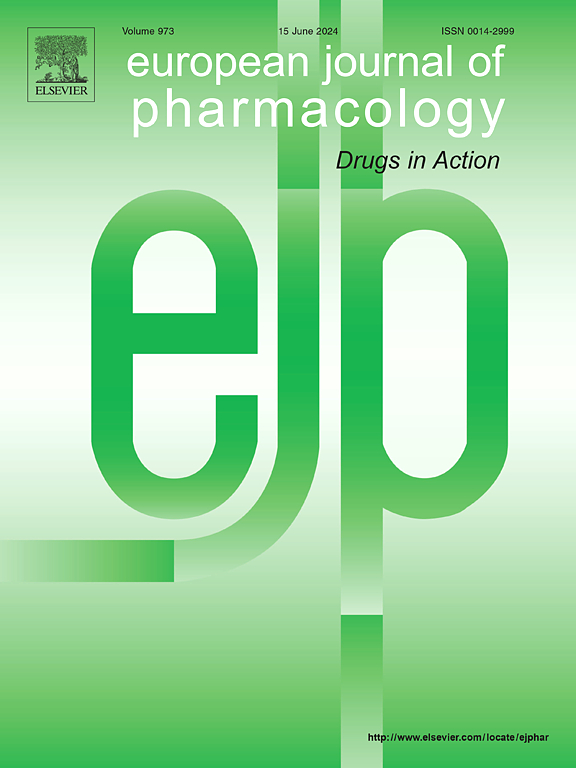Modulation of SIRT6 related signaling pathways of p-AKT/mTOR and NRF2/HO-1 by memantine contributes to curbing the progression of tamoxifen/HFD-induced MASH in rats
IF 4.2
3区 医学
Q1 PHARMACOLOGY & PHARMACY
引用次数: 0
Abstract
Metabolic dysfunction-associated steatohepatitis (MASH) is a chronic liver disorder marked by hepatic fat accumulation and inflammatory infiltrates which may evolve to cirrhosis. Clinical studies have demonstrated the higher risk of MASH development after tamoxifen (TAM) therapy, especially in obese patients. Therefore, we aimed to evaluate MASH induction by TAM combined with high fat diet (HFD) and the potential interference of memantine (MEMA) with MASH progression via modulation of SIRT6 and its related signaling pathways. MASH was induced in female Wistar rats by co-administration of TAM (25 mg/kg/day, p.o.) and HFD for 5 weeks. Liver function biomarkers, tissue triglyceride and cholesterol, MASH scoring, SIRT6 with its related signals, and lipid synthesis/oxidation markers were estimated. By comparison to MASH group, MEMA improved liver function indices (ALT, AST, ALP, albumin) and reduced the progression of MASH, evidenced by decreased accumulation of lipids in hepatic tissue, improved histological features, and reduced MASH scoring. MEMA enhanced hepatic SIRT6 and downregulated p-AKT/mTOR signaling, that subsequently reduced expressions of the lipid synthesis biomarkers (SREBP1c, SCD), while elevating the lipid oxidation markers (PPAR-α, CPT1). Moreover, MEMA enhanced NRF2/HO-1 signaling, with subsequently improved antioxidant defense and pro-inflammatory/anti-inflammatory cytokines balance. Analysis of SIRT6 correlations with p-AKT/mTOR, NRF2/HO-1, SREBP1c, and PPAR-α further confirmed our results. Consequently, we conclude that MEMA could interfere with MASH progression, at least in part, via enhanced SIRT6 expression and modulation of its related p-AKT/mTOR and NRF2/HO-1 signaling pathways, eventually reducing liver steatosis and inflammation. That could be a promising therapeutic modality for curbing MASH progression.
美金刚对SIRT6相关的p-AKT/mTOR和NRF2/HO-1信号通路的调控有助于抑制他莫昔芬/高密度脂蛋白胆固醇诱导的大鼠MASH的进展
代谢功能障碍相关性脂肪性肝炎(MASH)是一种以肝脏脂肪堆积和炎症浸润为特征的慢性肝脏疾病,可演变为肝硬化。临床研究表明,他莫昔芬(TAM)治疗后发生 MASH 的风险较高,尤其是肥胖患者。因此,我们旨在评估他莫昔芬联合高脂饮食(HFD)诱导 MASH 的情况,以及美金刚(MEMA)通过调节 SIRT6 及其相关信号通路对 MASH 进展的潜在干扰。在雌性 Wistar 大鼠体内同时给予 TAM(25 毫克/千克/天,p.o.)和高脂饮食 5 周,诱导 MASH。对肝功能生物标志物、组织甘油三酯和胆固醇、MASH评分、SIRT6及其相关信号和脂质合成/氧化标志物进行了评估。与 MASH 组相比,MEMA 改善了肝功能指标(谷丙转氨酶、谷草转氨酶、谷草转氨酶、白蛋白),并降低了 MASH 的进展,这表现在肝组织中脂类积聚减少、组织学特征改善和 MASH 评分降低。MEMA 增强了肝脏 SIRT6,下调了 p-AKT/mTOR 信号转导,从而降低了脂质合成生物标志物(SREBP1c、CPT1)的表达,同时提高了脂质氧化标志物(PPAR-α、SCD)的表达。此外,MEMA 还增强了 NRF2/HO-1 信号传导,从而改善了抗氧化防御和促炎/抗炎细胞因子的平衡。SIRT6与p-AKT/mTOR、NRF2/HO-1、SREBP1c和PPAR-α的相关性分析进一步证实了我们的研究结果。因此,我们得出结论:MEMA 可通过增强 SIRT6 的表达和调节其相关的 p-AKT/mTOR 和 NRF2/HO-1 信号通路,最终减轻肝脏脂肪变性和炎症,至少部分地干扰 MASH 的进展。这可能是一种很有前景的遏制MASH进展的治疗方法。
本文章由计算机程序翻译,如有差异,请以英文原文为准。
求助全文
约1分钟内获得全文
求助全文
来源期刊
CiteScore
9.00
自引率
0.00%
发文量
572
审稿时长
34 days
期刊介绍:
The European Journal of Pharmacology publishes research papers covering all aspects of experimental pharmacology with focus on the mechanism of action of structurally identified compounds affecting biological systems.
The scope includes:
Behavioural pharmacology
Neuropharmacology and analgesia
Cardiovascular pharmacology
Pulmonary, gastrointestinal and urogenital pharmacology
Endocrine pharmacology
Immunopharmacology and inflammation
Molecular and cellular pharmacology
Regenerative pharmacology
Biologicals and biotherapeutics
Translational pharmacology
Nutriceutical pharmacology.

 求助内容:
求助内容: 应助结果提醒方式:
应助结果提醒方式:


